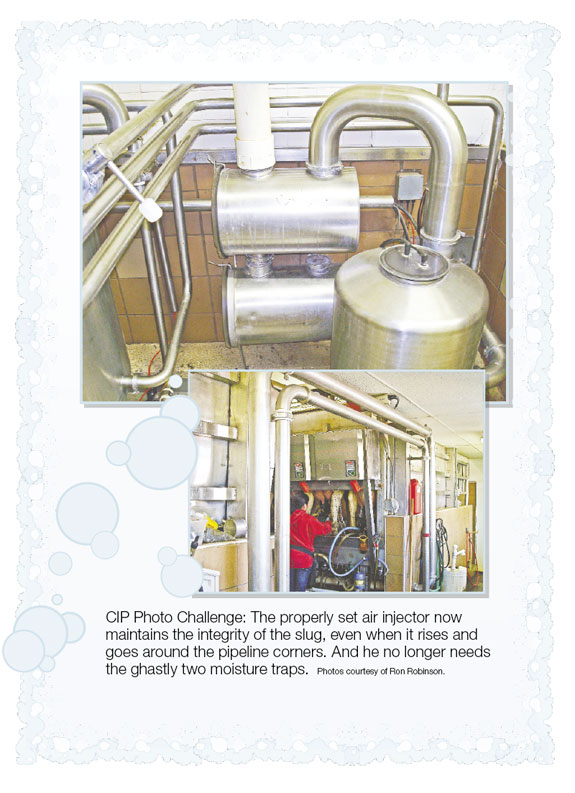It’s a recurring nightmare. Dairy producers shocking their CIP system in hopes to get it clean. Too many times we hear about the gory details, instead of a happy ending. Such is the case with a Wisconsin farmer milking almost 900 cows, three times a day. He was shocking his system every Saturday, hoping to reduce bacteria counts. In order to shock the system with an alkaline/chlorine base product, this producer pinched off the hose leading to the acid base product, because the two products are not compatible.
Gory Detail #1 – The pinching caused the pump to wear out.
When we arrived and inspected the operation, we noticed that the chemical pump wasn’t working properly. The herd owner said, “That’s probably because they told me I had to pinch off the hose to shock the system.”
Unfortunately, by pinching the hose the producer inadvertently wore out the pump and was essentially washing the system with just hot water. And we discovered the water was dangerously hot.
Gory Detail #2 – When things weren’t getting clean, the milking team turned up the water to 185°F, hoping that the hotter temperatures would help. The herd owner was extremely concerned that someone would get burned, not to mention the money he was wasting to heat the water.
Wash temperatures should be no more than 160°F. Anything above that is wasting energy – and jeopardizing safety.
Gory Detail #3 – Two moisture traps? Huh…
During our evaluation, we discovered two moisture traps. With more than 30 years of improving CIP systems, I’ve never seen this type of set-up. The two traps led to a misadjusted air injector, causing the water slug to go through the pipeline too fast. When the slug hit the receiver, the water would splash and the vacuum sucked it up into the moisture trap. There was so much extra water that a second moisture trap was installed. I scratched my head, wondering why wasn’t the air injector adjusted correctly instead?
General mechanical effects
• Air injectors must be correctly adjusted so that each slug will completely and properly traverse the entire parlor pipeline without breaking down.
• The slug must also maintain adequate shear force during its circuit so that the cleaning action is consistent throughout the entire system.
One, two, three washes
Before taking any action, we first evaluated this Wisconsin producer’s system through one complete washing. Then we sat down with the owner to discuss how we would fix his “gory details” and reset his system so that it could wash properly.
During the second milking shift that day, we fixed his pump, hot water heater and air injector, and also replaced worn-out plastic and rubber parts. The changes worked well and we sent the herd owner home – for a good night’s sleep.
When we came back to the farm at 3 a.m. to monitor the changes during the third wash cycle, we discovered Gory Detail #4. The pressure switch failed and didn’t activate the vacuum pump to start the wash cycle. We manually started the system on the milk cycle so the vacuum pump would kick in and at least rinse the system. A potentially dreadful nightmare was averted.
Sweet dreams
We recently followed up with this Wisconsin producer. His bacteria counts are stable and he no longer has to shock his system. He’s using 160°F water instead of 180°F, which saves him money and is safer for his employees. The properly set air injector now maintains the integrity of the slug, even when it rises and goes around the pipeline corners. And he no longer needs the ghastly two moisture traps.
Additional “happy ending” results he’s seen include:
• SPC counts below 5,000
• PI counts below 10,000
• LPC counts below 10
• Coliform counts consistently below 10
• Lower sanitation cost
• Lower energy cost
• Less wear and tear on the equipment
• Safer work environment
This CIP Challenge ended up being successful and rewarding. We hope it will help other producers fix their problems too – no more shocking, no more nightmares. PD

Want to know how well your CIP system is doing? Submit a photo of your CIP challenges or a question to Progressive Dairyman . In future issues, A&L Laboratories experts will comment on the photos or questions. Dairy names and locations will not be connected with photos, so your review will be completely anonymous. Send your photos and questions to walt@progressivedairy.com.

-
Ron Robinson
- VP Business Development
- A&L Laboratories
- Email Ron Robinson





